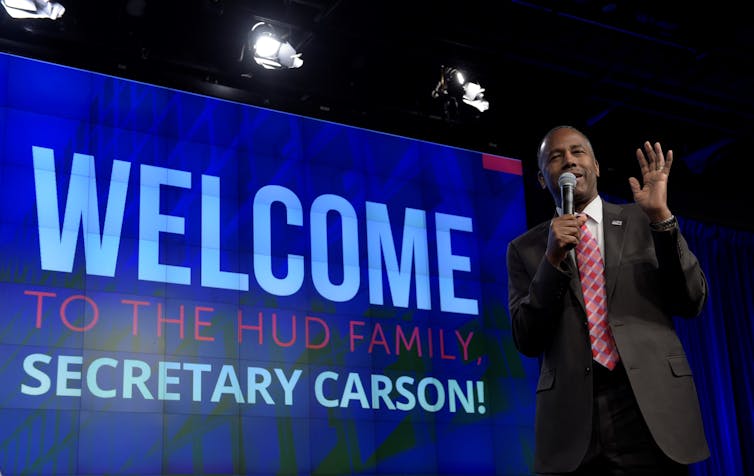What the staff does matters more than what's in an organization's mission statement
- Written by David Berlan, Assistant Professor of Public Administration, Askew School of Public Administration and Policy, Florida State University
Mission statements[1], not normally in the news, are getting more attention than usual.
The U.S. Citizenship and Immigration Services[2], the Department of Housing and Urban Development[3], the State[4] Department[5] and other federal agencies are changing the way they express their core purpose and focus. In many cases, the Trump administration is alarming observers[6] by deleting key phrases that signal diversity and inclusion.
My research on nonprofit mission statements[7], published in the Nonprofit Management & Leadership academic journal, however, suggests that there might be less to worry about than it appears. I have found that how people in a given organization personally understand its mission matters more than any formal statements summing it up.
Author Dan Heath, a Duke University professor, suggests a few ways to write strong mission statements.Tales of tinkering
In the summer of 2017, the State Department[8] replaced its mission statement with a new one. The old phrasing referenced democracy but the new one didn’t.
In February, the immigration agency altered[9] its long-running mission statement to omit references to the U.S. being “a nation of immigrants.”
Around the same time, some Veterans Administration employees temporarily altered[10] its motto without permission, replacing the line “to care for him who shall have borne the battle and for his widow, and his orphan” with “to care for those ‘who shall have borne the battle’ and for their families, caregivers, and survivors.” Their superiors overrode the change, which symbolically supported female veterans through gender-neutral language.
Then HUD Secretary Ben Carson said he wanted to change[11] the agency’s mission statement[12], removing its call to “build inclusive and sustainable communities free from discrimination.”
 Housing and Urban Development Secretary Ben Carson addressing HUD employees in March 2017.
AP Photo/Susan Walsh[13]
Housing and Urban Development Secretary Ben Carson addressing HUD employees in March 2017.
AP Photo/Susan Walsh[13]
What does the staff say?
Disagreements among managers, board members and staff regarding a group’s mission, values and other key ideas are relatively common[14] and even natural[15] at all kinds of agencies and groups. Yet a study of nonprofits[16] by scholars at three different universities found that nonprofits rarely change their formal mission statements. These researchers also found that the shifts that do occur tend to be driven most often by collaboration with their peers.
As I began my research, I expected changes in formal mission statements to be the most important signals of what an organization seeks to accomplish. But after interviewing the leaders and lower-ranking employees at a variety of nonprofits engaged in activities such as adult literacy, clean water and sanitation, I discovered that their own views mattered more.
Many of the same people cannot recall the exact language of their organization’s official mission statement, yet they have a clear and personal understanding of their nonprofit’s mission. These takes can be different within a single organization, as you might expect. People, after all, join nonprofits with different values and motivations. Their work requires them to focus on different activities, which absorb their attention and set distinct priorities.
As I compared the statements by real people to the words found in official documents like annual reports and on websites, including formal mission statements, I made another observation. Mission statements broadly establish an organization’s purpose, but they do not serve as the best guide for action. Instead, what truly guides an organization is the consensus among the people in it.
I also noticed two important trends. First, this somewhat informal consensus changes more often than formal mission statements. Second, the consensus may not match the personal views of senior leaders. Often, what the staff perceives is actually closer to the true mission within the organization than the formal written statement or the views of board members.
As for the Trump administration, it may find that changing the formal mission statements that guide agencies like HUD and U.S. Citizenship and Immigration Services will not achieve its desired political goals.
If civil servants continue to personally believe that they reside in “a nation of immigrants,” taking that expression out of their agency’s mission statement won’t have much of an impact. And HUD’s staff, likewise, may continue to make rooting out housing discrimination a high priority even if that’s no longer baked into that agency’s mission statement.
References
- ^ Mission statements (www.businessdictionary.com)
- ^ U.S. Citizenship and Immigration Services (www.vox.com)
- ^ Housing and Urban Development (www.huffingtonpost.com)
- ^ State (diplomacy.state.gov)
- ^ Department (web.archive.org)
- ^ alarming observers (www.npr.org)
- ^ research on nonprofit mission statements (onlinelibrary.wiley.com)
- ^ State Department (www.washingtonpost.com)
- ^ immigration agency altered (theintercept.com)
- ^ employees temporarily altered (www.washingtonpost.com)
- ^ HUD Secretary Ben Carson said he wanted to change (www.huffingtonpost.com)
- ^ mission statement (www.hud.gov)
- ^ AP Photo/Susan Walsh (www.apimages.com)
- ^ relatively common (www.tandfonline.com)
- ^ even natural (journals.sagepub.com)
- ^ study of nonprofits (journals.sagepub.com)
Authors: David Berlan, Assistant Professor of Public Administration, Askew School of Public Administration and Policy, Florida State University

